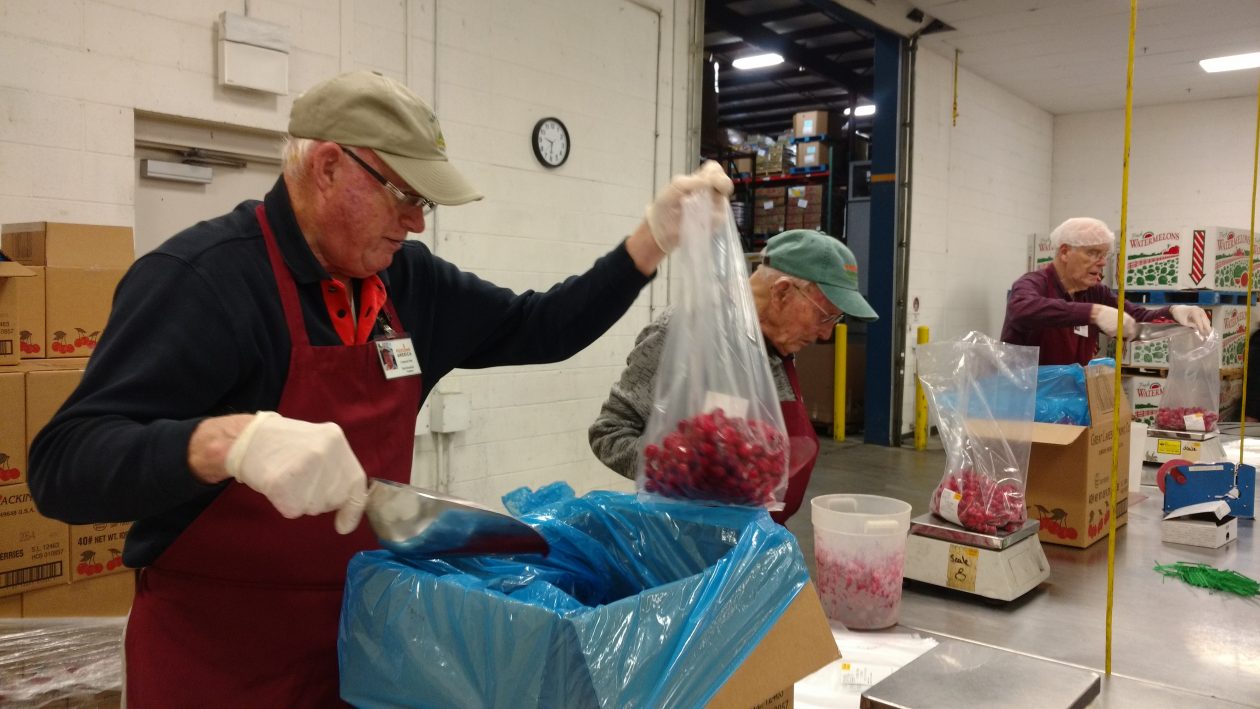At the food bank, numerous ceiling-high shelves are filled with an ever-cycling rotation of canned goods, juice boxes and other non-perishable food. In the back, spanning roughly half the length of our 55,000 sq. foot warehouse, stand both a walk-in refrigerator and freezer, holding fresh and individually quick frozen (IQF) produce, meat and dairy products, awaiting transit to the hands of neighbors in need.
Recently, we finished building a new freezer with a volume of 18,810 cubic feet. Nestled beside our existing freezer, it will enable us to accept more frozen food donations than ever before. In 2019, we were offered 250,000 pounds worth of frozen food that we couldn’t accept, simply because we didn’t have the capacity to store it. The year before, we were offered 400,000 pounds.

When we can’t accept a donation, the food has a high chance of ending up in a landfill, or becoming animal feed – instead of filling the plates of neighbors in need.
Sometimes, we’re offered large donations that are too good to turn down, so over the past few years, we’ve rented refrigerated trucks to store this food in our parking lot. This has meant leaving these trucks’ refrigerator units running for days on end. We’ve also paid for off-site freezer storage. For reclamation volunteers to sort and package this food, it needs to be transported to the food bank’s warehouse and back – an additional expense.
Building a new freezer with help from generous grantors
Thanks to the contribution of 10 grantors, we built our brand new freezer after doing some creative reorganizing in a part of the warehouse that once held recycling and dry food awaiting pick up from our partner agencies.
These grantors are Wege, ConAgra, the Feeding America National Organization, Grand Haven Area Community Foundation, Loutit Foundation, Frey Foundation, Peter C. and Emajean Cook Foundation, Kellogg Company, Parker-Hannifin and Meijer.
Thanks to their support, we can now accept thousands of pounds of safe, surplus food that we couldn’t before. Now, this nutritious food can fill neighbors’ freezers instead of landfills.
New freezer brings benefits and possibilities
Since frozen food is an essential and healthy option on the menu of many hunger-relief programs, our partner agencies have asked us for more options. The new freezer will enable us to balance fresh produce with frozen items to offer the best possible variety. Now, our partner agencies will have much more to choose from when ordering product and in turn, can better serve their clients.

Individually quick frozen (IQF) produce is incredibly fresh and, not only does it maintain its nutrition and taste (as opposed to other types of freezing), it has added benefits for families in need. Instead of worrying about how to make a bunch of fresh produce last until their next pantry visit (e.g. trying to freeze it), families who receive IQF food can store their items much longer and with less hassle.
On top of these benefits, the freezer also creates possibilities by saving money.
We can now better designate funds that have historically been spent on renting and maintaining refrigerated trucks and outside storage costs. For example, funds saved by our freezer can support our Fresh Start initiative to help neighbors make the most of the healthy food they receive by providing education sessions, activities, tools and resources.
Fresh and frozen produce essential for neighbors
Our 800+ partner agencies across 40 counties agree that both fresh and fresh-frozen foods are critical for the health of the neighbors they serve.
Sinceria runs a Mobile Food Pantry in Benton Harbor. She believes the more produce and protein she can offer to her neighbors, the better.
“It helps them to get away from so many processed foods and the fresh produce is more beneficial for their health,” she said.

Monique, a neighbor who receives food at Sinceria’s Mobile Pantry concurred. She’s always grateful to receive these items, especially since she cares for many family members: her two kids, her mother, and her two disabled siblings.
“Fruits and vegetables are so expensive at the store,” she said.
Without access to enough nutritious food, anyone’s health can suffer – especially seniors, who may be at higher risk for disease, and children, who may face stunted growth or struggle in school.
Michelle, who runs St. Alphonsus Food & Clothing Center, loves to see her organization’s fridge and freezer full. The traditional pantry will now have more opportunity to fill their freezer with fresh options for their neighbors.
“I think it’s important to offer a wide variety of healthy choices for folks,” Michelle said.
Our new freezer is more than just a home for frozen food, it’s also another step toward Feeding America West Michigan’s goal of ensuring all neighbors in West Michigan and the Upper Peninsula have access to the nutritious food they need to thrive. From these neighbors, and all of us at the food bank, we want to thank our supporters – whether they help donate a freezer, or simply give $10 to provide 40 meals. Thank you!

